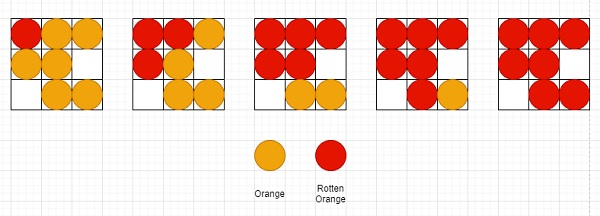
 Data Structure
Data Structure Networking
Networking RDBMS
RDBMS Operating System
Operating System Java
Java MS Excel
MS Excel iOS
iOS HTML
HTML CSS
CSS Android
Android Python
Python C Programming
C Programming C++
C++ C#
C# MongoDB
MongoDB MySQL
MySQL Javascript
Javascript PHP
PHP
- Selected Reading
- UPSC IAS Exams Notes
- Developer's Best Practices
- Questions and Answers
- Effective Resume Writing
- HR Interview Questions
- Computer Glossary
- Who is Who
Rotting Oranges in C++
Suppose we have a grid, here in each cell can have one of three values −
value 0 for an empty cell;
value 1 for a fresh orange;
value 2 for a rotten orange.
In every minute, any fresh orange that is adjacent to a rotten orange becomes rotten.
We have to find the minimum number of times that must elapse until no cell has a fresh orange. If this is not possible, then return -1.
So, if the input is like [[2,1,1],[1,1,0],[0,1,1]], then the output will be 4

To solve this, we will follow these steps −
minutes := 0
rowMax := row size of grid
colMax := col size of grid
freshLeft := false
newGrid := grid
-
while true is non-zero, do −
newGrid := grid
flag := false
freshLeft := false
-
for initialize i := 0, when i < rowMax, update (increase i by 1), do −
-
for initialize j := 0, when j < colMax, update (increase j by 1), do −
-
if newGrid[i, j] is same as 1, then −
-
if (i-1 >= 0 and newGrid[i-1,j] is 2) or (i+1 < rowMax and newGrid[i+1,j] is 2) or (j-1 >= 0 and newGrid[i,j-1] is 2) or (j+1 >= 0 and newGrid[i,j+1] is 2), then
grid[i, j] := 2
flag := true
freshLeft := true
-
-
-
-
if flag is non-zero, then −
(increase minutes by 1)
-
Otherwise
Come out from the loop
return (if freshLeft is not equal to true, then minutes, otherwise -1)
Example (C++)
Let us see the following implementation to get better understanding −
#include <bits/stdc++.h>
using namespace std;
class Solution {
public:
int orangesRotting(vector<vector<int>> &grid) {
int minutes = 0;
int rowMax = grid.size();
int colMax = grid[0].size();
bool freshLeft = false;
auto newGrid = grid;
while (true) {
newGrid = grid;
bool flag = false;
freshLeft = false;
for (int i = 0; i < rowMax; i++) {
for (int j = 0; j < colMax; j++) {
if (newGrid[i][j] == 1) {
if ((i - 1 >= 0 && newGrid[i - 1][j] == 2) or (i + 1 < rowMax && newGrid[i + 1][j] == 2) or (j - 1 >= 0 && newGrid[i][j - 1] == 2) or (j + 1 < colMax && newGrid[i][j + 1] == 2)) {
grid[i][j] = 2;
flag = true;
}
freshLeft = true;
}
}
}
if (flag)
minutes++;
else
break;
}
return (freshLeft != true) ? minutes : -1;
}
};
main() {
Solution ob;
vector<vector<int>> v = {{2, 1, 1}, {1, 1, 0}, {0, 1, 1}};
cout << (ob.orangesRotting(v));
}
Input
{{2, 1, 1}, {1, 1, 0}, {0, 1, 1}}
Output
4

